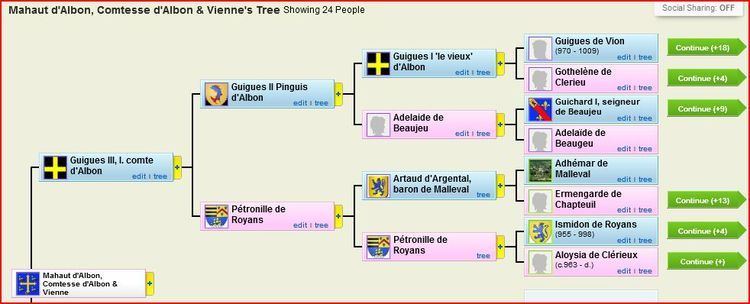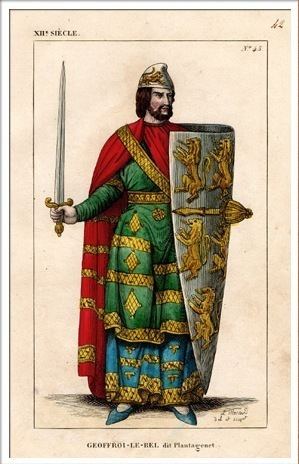Name Geoffrey V Predecessor Fulk the Younger Role Count of Anjou Name Geoffrey Count | Successor Henry Curtmantle | |
 | ||
Reign 1129 – 7 September 1151 Born 24 August 1113 ( 1113-08-24 ) IssueDetail Henry II, King of EnglandGeoffrey, Count of NantesWilliam, Viscount of Dieppe Died September 7, 1151, Chateau-du-Loir, France Children Henry II of England, Hamelin de Warenne, Earl of Surrey, Geoffrey, Count of Nantes, William FitzEmpress Parents Fulk, King of Jerusalem, Ermengarde, Countess of Maine Grandchildren Richard I of England, John, King of England Similar People Henry II of England, Empress Matilda, Henry I of England, Fulk - King of Jerusalem, Stephen - King of England | ||
Geoffrey plantagenet count of anjou
Geoffrey V (24 August 1113 – 7 September 1151) — called the Handsome or the Fair (French: le Bel) and Plantagenet — was the Count of Anjou, Touraine, and Maine by inheritance from 1129 and then Duke of Normandy by conquest from 1144. By his marriage to the Empress Matilda, daughter and heiress of Henry I of England, Geoffrey had a son, Henry Curtmantle, who succeeded to the English throne as King Henry II (1154-1189) and was the first of the Plantagenet dynasty to rule England; the name "Plantagenet" was taken from Geoffrey's epithet. His ancestral domain of Anjou gave rise to the name Angevin for three kings of England (Henry II his son and heir, and Henry's sons Richard and John), and what became known as the Angevin Empire in the 12th century.
Contents
- Geoffrey plantagenet count of anjou
- Early life
- Marriage
- Count of Anjou
- Death
- Children
- Early heraldry
- References

Early life

Geoffrey was the elder son of Foulques V d'Anjou and Eremburga de La Flèche, daughter of Elias I of Maine. He was named after his great-grandfather Geoffrey II, Count of Gâtinais. Geoffrey received his nickname from the yellow sprig of broom blossom (genêt is the French name for the planta genista, or broom shrub) he wore in his hat. King Henry I of England, having heard good reports on Geoffrey's talents and prowess, sent his royal legates to Anjou to negotiate a marriage between Geoffrey and his own daughter, Empress Matilda. Consent was obtained from both parties, and on 10 June 1128 the fifteen-year-old Geoffrey was knighted in Rouen by King Henry in preparation for the wedding.
Marriage

Geoffrey and Matilda's marriage took place in 1128. The marriage was meant to seal a peace between England/Normandy and Anjou. She was eleven years older than Geoffrey, and very proud of her status as empress dowager (as opposed to being a mere countess). Their marriage was a stormy one with frequent long separations, but she bore him three sons and survived him.
Count of Anjou

The year after the marriage Geoffrey's father left for Jerusalem (where he was to become king), leaving Geoffrey behind as count of Anjou. John of Marmoutier describes Geoffrey as handsome, red-headed, jovial, and a great warrior; however, Ralph of Diceto alleges that his charm camouflaged a cold and selfish character.
When King Henry I died in 1135, Matilda at once entered Normandy to claim her inheritance. The border districts submitted to her, but England chose her cousin Stephen of Blois for its king, and Normandy soon followed suit. The following year, Geoffrey gave Ambrieres, Gorron, and Chatilon-sur-Colmont to Juhel de Mayenne, on condition that he help obtain the inheritance of Geoffrey's wife.
In 1139 Matilda landed in England with 140 knights, where she was besieged at Arundel Castle by King Stephen. In the "Anarchy" which ensued, Stephen was captured at Lincoln in February 1141, and imprisoned at Bristol. A legatine council of the English church held at Winchester in April 1141 declared Stephen deposed and proclaimed Matilda "Lady of the English". Stephen was subsequently released from prison and had himself recrowned on the anniversary of his first coronation.
During 1142 and 1143, Geoffrey secured all of Normandy west and south of the Seine, and, on 14 January 1144, he crossed the Seine and entered Rouen. He assumed the title of Duke of Normandy in the summer of 1144. In 1144, he founded an Augustine priory at Château-l'Hermitage in Anjou. Geoffrey held the duchy until 1149, when he and Matilda conjointly ceded it to their son, Henry, which cession was formally ratified by King Louis VII of France the following year.
Geoffrey also put down three baronial rebellions in Anjou, in 1129, 1135, and 1145–1151. He was often at odds with his younger brother, Elias, whom he had imprisoned until 1151. The threat of rebellion slowed his progress in Normandy, and is one reason he could not intervene in England. In 1153, the Treaty of Wallingford stipulated that Stephen should remain King of England for life and that Henry, the son of Geoffrey and Matilda should succeed him.
Death
Geoffrey died suddenly on 7 September 1151. According to John of Marmoutier, Geoffrey was returning from a royal council when he was stricken with fever. He arrived at Château-du-Loir, collapsed on a couch, made bequests of gifts and charities, and died. His wife and sons outlived him. He was buried at St. Julien's Cathedral in Le Mans France, and Henry succeeded him as Duke of Normandy
Children
Geoffrey and Matilda's children were:
- Henry II of England (1133–1189)
- Geoffrey, Count of Nantes (1 June 1134 Rouen- 26 July 1158 Nantes) died unmarried and was buried in Nantes
- William, Viscount of Dieppe (1136–1164) died unmarried
Geoffrey also had illegitimate children by an unknown mistress (or mistresses): Hamelin; Emme, who married Dafydd Ab Owain Gwynedd, Prince of North Wales; and Mary, who became a nun and Abbess of Shaftesbury and who may be the poet Marie de France. Adelaide of Angers is sometimes sourced as being the mother of Hamelin.
Early heraldry
An enamel effigy (funerary plaque) commissioned by his widow to decorate the tomb of Geoffrey of Anjou is one of the earliest examples of European heraldry. Jean de Marmentier, a late-12th-century chronicler, reported that in 1128 Henry I of England knighted his son-in-law Geoffrey and granted him a badge of gold lions. A gold lion may already have been Henry's own badge, and different lion motifs would later be used by many of his descendants. The enamel shows Geoffrey with a blue shield depicting gold lions, apparently the same motif later used by a grandson of Geoffrey, William Longespee. In addition to being one of the first authentic representations of a coat of arms, according to British historian Jim Bradbury it "suggests possible evidence for the early use of what became the English royal arms".
